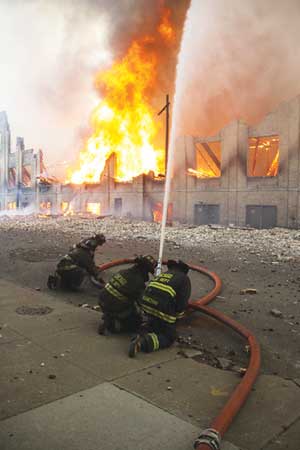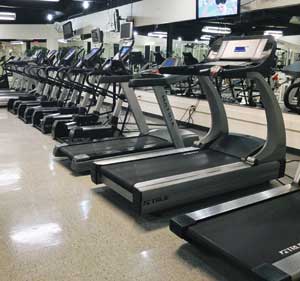By John F. “Skip” Coleman, Technical Editor
We all should have read Francis L. Brannigan’s Building Construction for the Fire Service. In this text, he says (and I paraphrase) that you should never work above or below a truss space involved in fire. Although I readily agree with the statement as it relates to working above a truss assembly involved in fire, I am not sure the word “never” should be used as it relates to working below a truss assembly. You need to know what’s below the assembly and if what is below is also supporting the assembly.
Think of what was below the truss assembly at the Hackensack Ford fire, which claimed the lives of five firefighters in 1988, compared with what is below the truss assembly in a garden-type apartment building. One had wide open spaces with absolutely nothing supporting the roof but the roof (trusses) itself that would prohibit or stymie a truss failure from falling to the floor below. The other has many wall assemblies (separating the different apartments and rooms therein) that aid in stopping or stymieing the truss assembly from falling to the floor below.
Roundtable question: Does your department have a policy concerning working above or below truss assemblies involved in fire?
 |
| PHOTO OF THE DAY: Chicago firefighters respond to an alarm at a two-story warehouse. (Photo by Tim Olk/olkee.smugmug.com.) See more photos at http://emberly.fireengineering.com/photo-of-the-day.html. Send your Photo of the Day submissions to Peter Prochilo (peterp@pennwell.com). |
WEBCASTS
Join us for monthly Webcasts featuring the best of Fire Engineering authors and FDIC speakers. Battalion Chief (Ret.) William Peters, Jersey City (NJ) Fire Department, presents “Apparatus Purchasing: Back to Basics” on Thursday, March 21, 2013. This is a comprehensive guide to lead your department through the process of purchasing apparatus. Webcasts are free, but you must register!
FIRE LIFE

Michael Krueger writes in “Gym Intimidation”: “You know you must have a high degree of fitness to be a firefighter. You know that this means getting in some gym time as well as skills training. You know that if the fitness of even one member of the crew is lagging, it negatively affects everyone. Ultimately your fitness is up to you, but having a supportive environment to work out in where everyone feels comfortable and part of the team makes your training more pleasant as well as more effective.” See more on fitness, cooking, health, sports, and hunting at www.firelife.com.
FEATURED ARTICLES
Matt Stroud is a 23-year veteran of Toyota Motor Corporation, a Toyota-certified master diagnostic technician and an ASE certified master diagnostic technician certified in hybrid technology. In “Electric Vehicles and Their Charging Stations,” he writes: “As the price of fuel increases, many of us are searching for a cleaner and more efficient mode of transportation. We would all like to stay away from the gas station as long as possible. For many years now, new car options have been emerging, including hybrids, ultra efficient gasoline or diesel, alternative fuel, and electric vehicles. In this article, we are going to explore the electric vehicle charging station and some of the potential risks involved with this power source for vehicles.” (http://bit.ly/W4oTa5)
Brock Archer, former assistant chief, Hopland (CA) Fire Department, writes in “Don’t Forget About the 12-Volt Battery”: “These days, there is a lot of concern with high-voltage components and cabling in hybrid and electric vehicles, but what about 12-volt cabling? Can low-voltage cables be a hazard at a motor vehicle accident?” (http://bit.ly/X3735R)
Ray McCormack, a 30-year veteran and a lieutenant with the Fire Department of New York, writes in “Great Expectations”: “Do you have great expectations or just plain old regular expectations for yourself, your department, and the fire service itself this year? Great is beyond good and a much higher level than satisfactory as a grading. A great expectation is neither an unreasonable nor unreachable goal if you put in the time and effort required to reach it.” (http://bit.ly/ZUbyC2)
David DeStefano, a 23-year veteran of and a lieutenant with the North Providence (RI) Fire Department, writes in “Sweat the Small Stuff”: “Remember the old saying that admonishes us not to ‘sweat the small stuff’ or worry about the little details? As firefighters, we can never be so carefree! Attention to detail allows us to operate more efficiently and may help preserve our life or the life of another. ‘Sweating the small stuff’ begins with personal preparedness and should carry through everything we do as firefighters.” ( http://bit.ly/V7c8zY)
Sam Baretich, a captain with the Aberdeen (WA) Fire Department, writes in “The Next Guy”: “This story is a satire of four fire service employees: Everybody, Somebody, Nobody, You, and The Next Guy. You’re probably saying, ‘Wait, that’s five employees. This guy can’t even count, let alone do a hydraulics formula in his head!’ You will understand my math shortly.” (http://bit.ly/13Ad1C5)
COMMUNITY MEMBER OF THE MONTH |
||
|
Name: Edward Dunbar. Department: Benton County (WA) Fire District 4. Title/rank: training chief. Years of public service: three career, 22 volunteer. Agency structure: combination department. Top issues in your department: training, communication, budget. Topics you provide training for: EMS, fire suppression, basic hazmat, wildland. |
 |
|
Fire Engineering Archives


